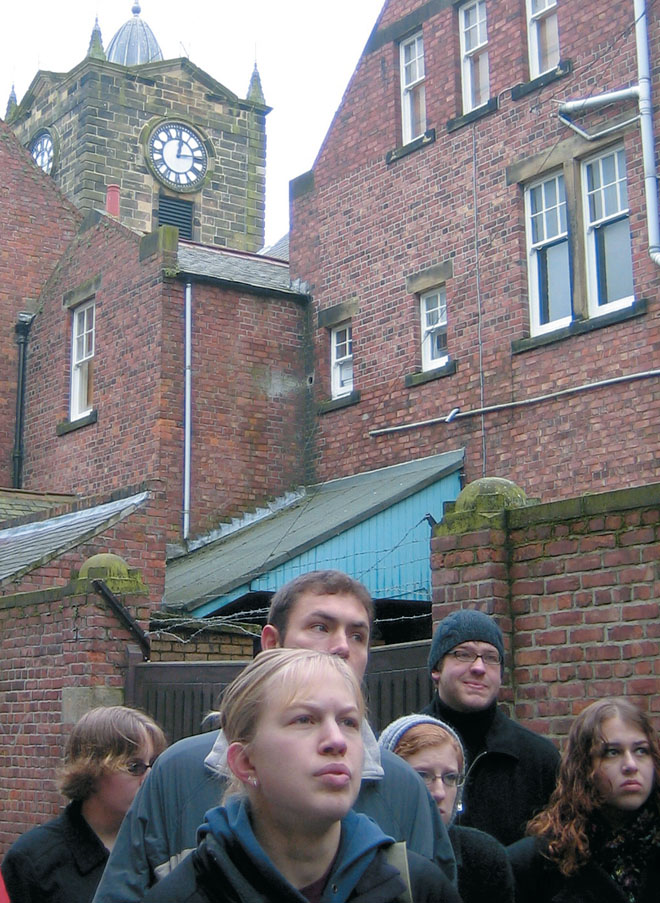
Study abroad amidst ghosts and battlements
THE PARTICIPANTS in St. Cloud State University’s British Studies Program, St. Cloud, Minnesota, know they are not the first to occupy their branch campus, Alnwick Castle in Northumberland. A list of the castle’s previous occupants, though, including those who built it, conquered it, surrendered it, purchased it, renovated it, studied in it or used it as a film set, astounds them. For more than 30 years, St. Cloud students arriving at Alnwick, sometimes at night through rain-washed cobblestone streets, and settling into a castle tower with a life-sized Harry Hotspur galloping right outside their window, have had a bit of pleasant culture shock. There’s even a resident ghost, the (apparently friendly) Grey Lady who haunts the Diana Tower.
The second-largest inhabited castle in England (after Windsor) raises its towers and turrets over the Northumber land countryside. While portions of it have disappeared, including the old dungeon, portcullis and many outbuildings, an astonishing amount remains intact. Some of the stone figures guarding the towers are 14th century, but the others were added four centuries later and are, in fact, garden gnomes. Towers line the walls of the outer bailey. Part of a bailey wall was removed in modern times to provide a better view into the adjacent park, landscaped by Capability Brown. Various celebrations take place in the park; rock group Queen performed there this past July.
Yves de Vescy, Baron of Alnwick, built Alnwick in motte and bailey style on the English-Scottish border in 1096 as a defense against the invading Scots. By 1309 its owner was Antony Bek, Bishop of Durham. That year, Henry de Percy bought it from him, and the Percy family, earls and later dukes of Northumberland, have owned it ever since. Henry IV besieged and captured it, the Wars of the Roses and the Civil War of 1642-1655 raged around it, but the Percys prevailed.
The Percys were a colorful lot, arriving with William the Conquerer and increasing their political power over the years. Most famous was Harry, nicknamed “Hotspur,” born in the castle in 1364, who became a symbol of knighthood at its finest. He fought his first battle at age eight, was knighted at 11, and helped to depose Richard II and bring Henry IV to the throne.
[caption id="AmericanStudentsatAlnwickCastle_img1" align="aligncenter" width="660"]

COURTESY OF ST. CLOUD STATE
Henry the sixth Earl had the bad luck to fall in love with a lady on whom Henry VIII already had his eye. Not only could he not marry Anne Boleyn, but the king forced him to marry someone else, testify against Anne at her trial and give his lands to the crown.
His son, Thomas Percy seventh earl, regained his earldom and ancestral lands, but was executed for supporting Mary Queen of Scots against Elizabeth I. The eighth earl died in the Tower of London for the same cause. Henry the ninth earl, wound up in the Tower, too. Known as the “Wizard Earl” for his great knowledge of astronomy, navigation, science and cartography, he had the misfortune to be cousin to Thomas Percy, participant in the Gunpowder Plot. The Wizard Earl spent 17 fairly painless years in the Tower, where he lived in a comfortable apartment and employed a gardener.
Family involvement with Alnwick declined over subsequent generations until it was revived by Elizabeth Seymour, and her husband, Hugh Smithson, Earl and first Duke of Northumberland. Elizabeth moved her family into the castle and gave it new life.
During World War II, children were evacuated to safety at the castle. Following the war, it housed a girls’ high school, then a training college for teachers, who were in short supply. The first St. Cloud State students arrived in 1976.
Alnwick also provides a home for the present Duke’s family and offices for his Northumberland Estates. Some of the private rooms, Italianate on a grand scale, are open to visitors when the family are away. Visitors can see the ante-library, where the fine woodwork sets off the Titians and other Venetian school paintings. The library displays books collected by generations of Percys. The saloon, drawing room, breakfast room and dining room boast ancestral portraits and furnishings collected over the years. The chapel glows with tapestries brought back from the Continent by the fourth Duke.
Today’s Alnwick students return with tales of fairytale surroundings, huddling around a radiator to keep warm, tea parties to introduce them to varieties of British sweets, walks in the countryside that turn into walks in the journey of life, making lifelong friends (and more than a few marriages), and of having experiences that leave them forever changed. As history student Eric Berg put it, “When you first go into the castle, it’s kind of shock and awe to see something that old and that big. It’s an enchanting, romantic place.”





Comments